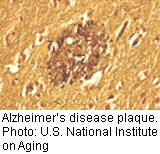- Skip Storing This Everyday Product in the Fridge Door
- Green Tea + B3 Pairing May Boost Brain Health
- Navigating Your Midlife Crisis: Embracing New Possibilities
- City Raccoons Showing Signs of Domestication
- Mapping the Exposome: Science Broadens Focus to Environmental Disease Triggers
- One Week Less on Social Media Linked to Better Mental Health
- Your Brain Changes in Stages as You Age, Study Finds
- Some Suicide Victims Show No Typical Warning Signs, Study Finds
- ByHeart Formula Faces Lawsuits After Babies Sickened With Botulism
- Switch to Vegan Diet Could Cut Your Greenhouse Gas Emissions in Half
Researchers Pinpoint Possible Protein Culprit Behind Alzheimer’s


Abnormal tau protein collecting in the brain may be the main cause of Alzheimer’s disease, a new study claims.
Another protein called amyloid accumulates as Alzheimer’s progresses, but is not the primary culprit behind the devastating memory loss that is the hallmark of the disease, Mayo Clinic researchers report.
They said their findings suggest that targeting tau should be the new focus of efforts to find treatments for Alzheimer’s.
“The majority of the Alzheimer’s research field has really focused on amyloid over the last 25 years,” study author Melissa Murray, a neuroscientist at the Mayo Clinic in Jacksonville, Fla., said in a Mayo news release.
The researchers analyzed 1,375 brains of deceased Alzheimer’s patients in the Mayo Clinic’s brain bank. The patients died at different ages and at different stages of Alzheimer’s, providing a timeline for disease progression.
The Alzheimer’s patients’ brains were compared with more than 2,200 brains that were free of the disease. The findings were published March 24 in the journal Brain.
“Initially, patients who were discovered to have mutations or changes in the amyloid gene were found to have severe Alzheimer’s pathology — particularly in increased levels of amyloid. Brain scans performed over the last decade revealed that amyloid accumulated as people progressed, so most Alzheimer’s models were based on amyloid toxicity. In this way, the Alzheimer’s field became myopic,” Murray explained.
“Tau can be compared to railroad ties that stabilize a train track that brain cells use to transport food, messages and other vital cargo throughout neurons. In Alzheimer’s, changes in the tau protein cause the tracks to become unstable in neurons of the hippocampus, the center of memory,” Murray said.
“Evidence suggests that abnormal tau then spreads from cell to cell, disseminating pathological tau in the brain’s cortex. The cortex is the outer part of the brain that is involved in higher levels of thinking, planning, behavior and attention — mirroring later behavioral changes in Alzheimer’s patients,” she continued.
“Amyloid, on the other hand, starts accumulating in the outer parts of the cortex and then spreads down to the hippocampus and eventually to other areas… . When you account for the severity of tau pathology, however, the relationship between amyloid and cognition disappears — which indicates tau is the driver of Alzheimer’s,” Murray concluded.
More information
The U.S. National Institute on Aging has more about Alzheimer’s disease.
Source: HealthDay
Copyright © 2025 HealthDay. All rights reserved.










